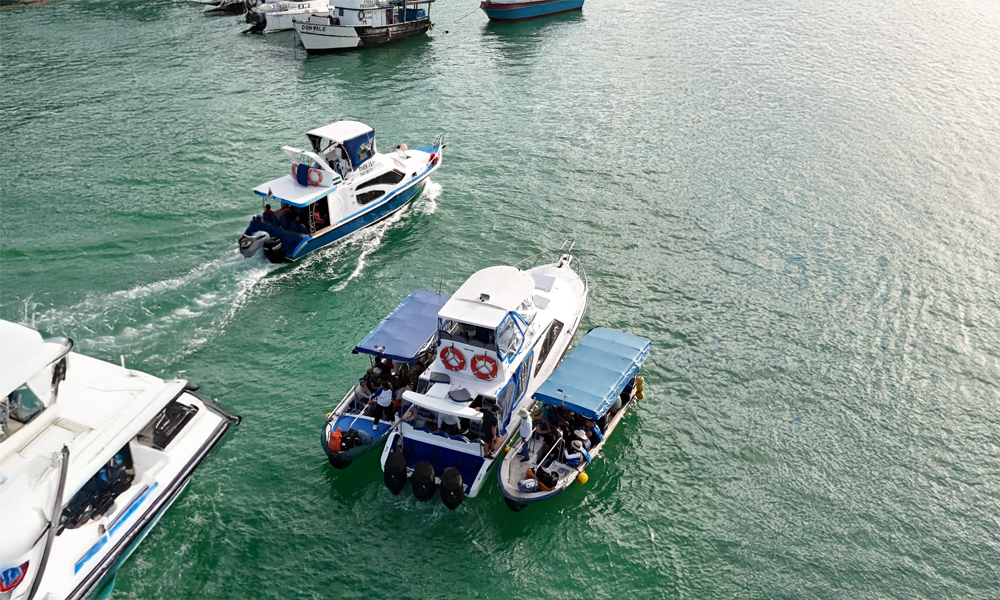|
•
|
||||||||
|
||||||||
|
|
||||||||

|
||||||||
|
If you’re planning to explore more than one island during your trip, inter-island ferries are the main way to get around the Galapagos. These speedboats connect Santa Cruz (Puerto Ayora), Isabela (Puerto Villamil), and San Cristobal (Puerto Baquerizo Moreno) islands, and the experience can be smooth and enjoyable once you know how things work. Here’s everything you need to know — directly from the team at Galapagos Seaways. Please note that there is not direct ferry from San Cristobal to Isabela and vice versa without a layover in Santa Cruz first, well unless you charter one.
Booking Your FerryFirst, personally we always recommend booking everything in advance, why not the ferries too then? Although, ferries don’t need to be booked months in advance, perhaps a week or more depending on the season, and you can do it online. You can also buy your ticket in person at almost any local agency on any town/island. They all work with the same shared boats (online and offline), so you’ll pay the same fare no matter where you book. During low season, it’s usually fine to buy your ticket one or two days in advance. In high season, we recommend booking earlier to make sure you get a seat. The big question, why online prices are higher? - When you book through an official website, a small additional cost covers more than just card transaction fees. It includes the maintenance of the platform, staff managing real-time availability, secure payment systems, and continuous website development. These small fees help keep the online system reliable, secure and updated. Still, if you’re already on the islands, buying in person can save you a few dollars plus a walk in town.
Fares and RoutesStandard fares vary between $25.00 to $50.00 or even more, depending on if it is online, offline or in cash or in card – online purchases are always in card. This applies to all routes and schedules.
Checking InOn the day of your trip, you’ll need to check in at the registration desk before boarding in the main pier/dock of town:
You’ll be asked for your speedboat name and your full name, ID may be asked to verify the manifest. Avoid lining up behind big tour groups, their guides usually handle multiple passengers at once, and the process can take longer, or travelers already checked in and lining up for biosecurity control. Keep in mind that ferry schedules are strict. Crews will help as much as possible, but boats can’t wait for late passengers.
Biosecurity ControlBefore boarding, your bags go through an inspection to make sure you’re not bringing in seeds, soil, or other non-native materials, the official name is ABG, and all traveler’s bags and luggage must go through it. After that, you’ll get a lanyard with your boat’s name, this acts as your boarding pass and will be checked again when you enter the ferry.
Avoiding Motion SicknessThe best seats for stability are on the lower deck near the engines. Arrive early to grab one of these spots. If you’re prone to seasickness, take medication like dimenhydrinate about an hour before departure and avoid eating heavy meals.
Layovers and LuggageIf your trip includes a layover in Santa Cruz, this means you will change speedboats, so take all your belongings with you, and if you purchase luggage storage, head to the location to store it. Otherwise, lockers near the dock cost about $4.00 per item.
Water TaxisThe small yellow boats or dinghies that take you from the pier to your main ferry, they charge $1.00 per person each way, it’s not a round trip. Bring $1.00 coins or small bills since drivers rarely carry change. Avoid $50 or $100 bills anywhere in Ecuador. Sitting at the front of the water taxi also helps you board the ferry first and pick your seat before others do.
Keep an Eye on Your LuggageWhen boarding the water taxis, passengers for multiple ferries might be on the same boat (for example, some going to Jenny, others to Gaviota). Make sure you know your ferry’s name and double-check that your luggage goes onto the right boat. Staff are usually very organized, but it’s good to keep an eye out, especially when it’s busy.
Enjoy the RideSome speedboats offer Wi-Fi, but once you’re in open water, the connection usually drops. There are no power outlets on board either, so make sure your phone or camera is charged before departure. Once you’re on board and settled in, relax and enjoy the ride. Ferry rides in Galapagos are not just a way to get from one island to another, they’re part of the experience. Use the trip as a moment to disconnect and enjoy the view, you might spot dolphins or fish flying along the way.
Galapagos Seaways offers all ferry routes between all three main inhabited islands: Santa Cruz, Isabela, and San Cristobal, connecting travelers safely and efficiently across the archipelago. Check availability and book online: www.galapagosseaways.com
|
||||||||
 |
 |
BLOG |
|
|
|
|
||||||
| © Galapagos a la Carte Galacarte S.A. | All rights reserved. | ||||||




|
||||||

|
||||||
|
||||||
 117
117









